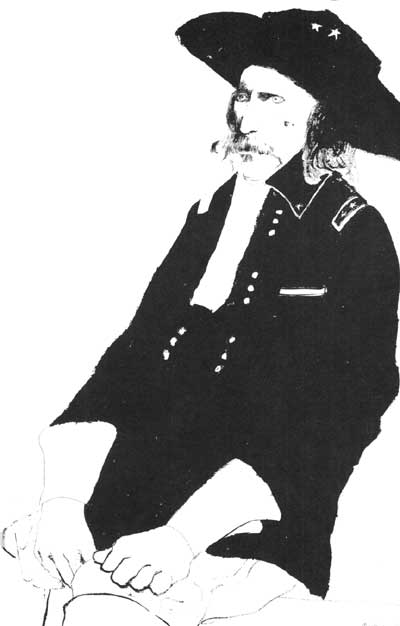|
LITTLE BIGHORN BATTLEFIELD National Monument |
 |

Maj. Gen. George A. Custer.
CUSTER'S LAST STAND
On a hot June Sunday in 1876, hordes of painted Indian warriors—perhaps as many as 4,000—swarmed over a treeless Montana ridge rising from the Little Bighorn River Valley. Five companies of U.S. Cavalry, about 215 blue-shirted troopers, contended briefly and hopelessly against overwhelming odds. When the guns fell silent and the smoke and dust of battle lifted, every soldier lay dead.
This was "Custer's Last Stand" the most spectacular triumph of the American Indian in his four-century struggle against the relentlessly advancing European civilization that finally crushed him. It forms a chapter of American history that has inspired intense study and provoked intense controversy, that has been chronicled endlessly in prose and verse and enacted time and again on motion picture and television screens, and that has earned a lasting place in the Nation's historical annals and popular folklore. In total defeat and death, Custer and his men achieved an immortality that even the most dramatic victory could not have won them.
After the close of the Civil War, the Nation resumed its westward march. An army of workmen pushed the rails of the Union Pacific up the Platte River Valley, to meet and join in 1869 with the Central Pacific beyond the Rocky Mountains. The Northern Pacific built from St. Paul, aiming for Dakota Territory and ultimately the Pacific Northwest. Steamers worked up the Missouri River, carrying passengers and freight to Fort Benton for the land journey to the gold mines of western Montana. Along the railroad and steamboat routes, the U.S. Army built forts and stationed troops to guard travelers and settlers.
Between the Platte on the south, the Missouri on the east and north, and the Rockies on the west dwelled several powerful Indian tribes. In numbers, wealth, and warlike inclination, none surpassed the seven tribes of Teton Sioux that roamed the buffalo plains stretching westward from the Missouri to the foothills of the Bighorn Mountains. Frequently allied with the Sioux were the less numerous but equally warlike Northern Cheyennes. In 1866 the Sioux and Northern Cheyennes reacted violently to the white man's attempt to open a road through the western half of this domain. They had recently wrested the Powder River country from the Crow tribe and had no desire to see it overrun with gold seekers hastening to the Montana diggings. For 2 years, even though the Army built three guardian forts, the Sioux made travel on the Bozeman Trail a dangerous and often fatal undertaking.
The Red Cloud War ended in 1868 with the Fort Laramie Treaty. The Indians thought they had won, for the hated forts were abandoned, the road closed, the Powder River country guaranteed as unceded hunting grounds, and all of present South Dakota west of the Missouri set aside as the Great Sioux Reservation. But the treaty also contained the seeds of their ruin, for it bound the Sioux to settle on the vast new reservation. Free rations lured many to the agencies at once. Others, following the example of the proud chieftain Sitting Bull, remained in the unceded hunting range, determined never to fall under the white man's domination.
The latter groups soon acquired the label "hostiles"; they occasionally committed depredations on the Montana settlements and openly fought the military units that escorted Northern Pacific Railroad surveyors into the Yellowstone River Valley in 1872 and 1873. The former groups, the "friendlies," accepted Government control and gathered at agencies on the Missouri and White Rivers. Between hostiles and friendlies, however, there was much mobility; as families tired of one life, they set forth to try the other.

One of Custer's scouts.
The Sioux had fought the Red Cloud War simply to prevent white prospectors from tramping across their country to the Montana goldfields. Now from the very heart of their country came rumors of gold deposits sparkling in the clear streams of the Black Hills. These forested, game-rich slopes lay within the Great Sioux Reservation, guaranteed to the Indians by the Treaty of 1868. But in 1874 a dramatic confirmation of the rumors set off a rush to the new bonanza. Vainly the Army tried to turn back the gold seekers, and vainly the Government sought to buy the Black Hills from the Sioux.
The Black Hills episode catalyzed the discontent that had smoldered on both sides since 1868. The Sioux justly charged the Government with breaking the Fort Laramie Treaty by permitting encroachment on Indian land and by failing to provide at the agencies all the goods and services promised. The whites justly charged the Sioux with breaking the treaty by raiding the settlements and travel routes fringing the Indian domain. As the Powder River bands swelled with discontented agency Sioux in 1875, the Government laid plans to end their troublesome aggressions and, perhaps in the process, frighten the agency chiefs into selling the Black Hills.
So long as the Indians did not have to depend on the Government for food, they could not be fully controlled. And so long as they had access to the abundant game resources of the unceded hunting grounds, they would not be dependent. Late in December 1875, therefore, swift native runners left the Sioux agencies bearing an ultimatum from the Commissioner of Indian Affairs to the Powder River bands: report at the agencies by January 31, 1876, or be classified as hostiles subject to military action. That the deadline allowed insufficient time for the move or that it was midwinter made little difference. The chiefs did not take the message seriously and made no effort to comply. On February 1, 1876, the Secretary of the Interior certified the Indians in the unceded territory as hostile and asked the Secretary of War to take such measures as he thought appropriate.

|
|
Last Modified: Sat, Sep 28 2002 10:00:00 pm PDT |


